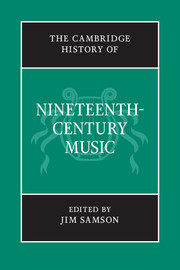Book contents
- Frontmatter
- Part One 1800–1850
- Part Two 1850–1900
- 11 Progress, modernity and the concept of an avant-garde
- 12 Music as ideal: the aesthetics of autonomy
- 13 The structures of musical life
- 14 Opera and music drama
- 15 Beethoven reception: the symphonic tradition
- 16 Words and music in Germany and France
- 17 Chamber music and piano
- 18 Choral culture and the regeneration of the organ
- 19 Music and social class
- 20 Nations and nationalism
- 21 Styles and languages around the turn of the century
- Chronology
- Institutions
- Personalia
- Index
- References
12 - Music as ideal: the aesthetics of autonomy
from Part Two - 1850–1900
Published online by Cambridge University Press: 28 March 2008
- Frontmatter
- Part One 1800–1850
- Part Two 1850–1900
- 11 Progress, modernity and the concept of an avant-garde
- 12 Music as ideal: the aesthetics of autonomy
- 13 The structures of musical life
- 14 Opera and music drama
- 15 Beethoven reception: the symphonic tradition
- 16 Words and music in Germany and France
- 17 Chamber music and piano
- 18 Choral culture and the regeneration of the organ
- 19 Music and social class
- 20 Nations and nationalism
- 21 Styles and languages around the turn of the century
- Chronology
- Institutions
- Personalia
- Index
- References
Summary
By the second half of the nineteenth century music had achieved a central position among the arts, to the extent that, as Walter Pater put it in 1877 in his now celebrated aperçu, ‘all art constantly aspires towards the condition of music’. This registered a remarkable change in the aesthetic status of music in the hundred years from the 1780s to the 1880s. From an art form regarded as a pleasant but meaningless entertainment without cognitive value, music had come to be viewed as the vehicle of ineffable truths beyond conceptualisation. Although the idea of art music as an autonomous, non-conceptual reflection of inwardness upon itself had remained a constant throughout this period, what had changed was the perception of music by the other arts and the interpretation of this non-conceptuality, particularly in philosophical aesthetics. While the focus in this essay is on music and ideas in the period from 1848, the centrality of the concept of autonomy to the other arts by the late nineteenth century also provides other vantage points from which to view a phenomenon which was to become largely naturalised within music itself. It can be argued, indeed, that for this very reason music calls for awareness of its reflections outside itself, in particular in literature and philosophy, in order for the implications of its autonomy and non-conceptuality to be recognised more fully. An example to illustrate this point is to be found in Joris-Karl Huysmans’s infamous novel A Rebours of 1884, a work which takes to its extremes the retreat into the inner world and the rejection of the dominant Realism and Naturalism of its time.
- Type
- Chapter
- Information
- The Cambridge History of Nineteenth-Century Music , pp. 318 - 342Publisher: Cambridge University PressPrint publication year: 2001



